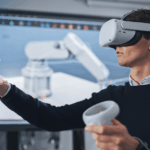eLearning isn’t what it used to be. Gone are the days of clicking through slide after slide of static text with a quiz at the end. Today’s learners expect engaging, interactive, and even personalized experiences. And that’s where an eLearning Developer comes in.
An eLearning Developer is the person who transforms training concepts into polished digital experiences. They know how to leverage the right tools, formats, and technologies to match your audience and your business goals. From short, mobile-friendly modules to immersive VR simulations, these professionals can design training that actually sticks.
Here’s a closer look at the wide range of learning experiences an eLearning Developer can create.
1. Microlearning
Definition: Microlearning is all about short, focused lessons that usually run between 2–5 minutes.
Why it works: In today’s fast-paced work environment, employees are juggling multiple priorities and don’t have the luxury of sitting through long training sessions. Attention spans are shorter, and learners often need information right when they’re about to use it. Microlearning delivers targeted content in small, digestible chunks, making it ideal for reinforcement, compliance reminders, or just-in-time learning. It’s training that respects both the clock and the learner’s brainpower.
Example: A 3-minute module showing sales reps how to update client info in a CRM system while they’re on the go—perfect for a quick refresher right before a client meeting.
2. Adaptive Learning
Definition: Adaptive learning technology personalizes the course path based on how the learner is performing.
Why it works: With shrinking attention spans, learners quickly tune out if training feels irrelevant. Adaptive learning solves this by tailoring content to what each person needs. Beginners get extra practice, while advanced learners skip ahead, saving time and frustration. It keeps learners engaged and ensures no one wastes time on material they already know.
Example: A compliance course that automatically skips sections learners have already mastered, letting them focus on new or high-risk areas.
3. Game-Based Learning & Gamification
Definition: Game-based learning is a full game designed around learning goals, while gamification means adding game elements like points, levels, or badges to training.
Why it works: In a busy workplace, keeping attention is half the battle. Games add motivation and competition that make training feel less like an obligation and more like a challenge. Whether through points, leaderboards, or branching role-play, games tap into natural engagement patterns to keep learners active instead of passive.
Example: A sales training program that includes a leaderboard and role-play challenges where reps compete to “close” simulated deals, building real skills while having fun.
4. Mobile Learning
Definition: Training designed specifically for smartphones and tablets.
Why it works: Work doesn’t always happen at a desk—and learning shouldn’t either. Mobile learning gives employees access to training anytime, anywhere, making it a true just-in-time resource. For field teams, traveling employees, or hybrid workforces, it’s an essential way to keep training relevant and accessible.
Example: A scenario-based module that field service employees can complete between client visits, right on their phones.
5. Live-Action Video
Definition: Training content filmed with real people, real settings, and real conversations.
Why it works: In today’s world of TikTok and YouTube, video is the language most people prefer. Live-action video feels authentic and helps learners connect emotionally to the material. It’s also fast to consume, making it a great option for companies looking to match the way employees already seek out information in their daily lives.
Example: A customer service training video where learners choose how the representative should respond, then watch the outcomes unfold.
6. Animated Video
Definition: Storytelling through animated characters, motion graphics, or explainer-style visuals.
Why it works: Attention spans may be short, but animation grabs attention quickly. Animated video can simplify complex ideas, break them into bite-sized chunks, and add a creative spark that makes learning more memorable. It’s also flexible—you don’t need actors or a set, which makes it perfect for topics that change frequently or require visuals you can’t film in real life.
Example: An animated explainer video showing how phishing scams work and what employees should look for in suspicious emails.
7. Software Simulations
Definition: Interactive, hands-on practice environments that replicate a software application.
Why it works: Learning by doing is still the gold standard, especially in today’s digital workplaces. Employees can’t afford trial and error in a live system, so simulations provide a safe, fast way to get comfortable with tools before they use them on the job. This cuts down on mistakes and makes adoption smoother.
Example: A simulation that teaches new hires how to enter data into Salesforce by guiding them step by step through mock entries.
Read Our Case Study on System Simulations
8. Augmented Reality (AR)
Definition: AR overlays digital elements onto the real world through smartphones, tablets, or specialized glasses.
Why it works: Time is money, and employees often need instructions in the exact moment they’re performing a task. AR provides contextual, just-in-time guidance that blends digital learning with the real-world setting. It’s especially valuable in fast-paced environments like manufacturing, healthcare, or field service.
Example: An AR app that allows technicians to point their phone at a machine and see step-by-step repair instructions overlaid on the equipment.
9. Virtual Reality (VR)
Definition: VR creates a fully immersive, 360-degree digital environment where learners can interact with scenarios.
Why it works: VR is the ultimate attention-grabber. It removes distractions by immersing learners completely, making it easier to focus and retain information. It’s particularly effective for high-stakes, fast-moving scenarios where employees need to practice decision-making without real-world risks.
Example: A VR training program that puts employees inside a simulated emergency evacuation, helping them practice procedures safely and confidently.
Bringing It All Together
As you can see, an eLearning Developer wears many hats. They combine instructional design principles, technical skills, and creativity to build training that actually makes a difference. Whether your business needs quick microlearning modules, hands-on simulations, or immersive AR/VR, an experienced eLearning developer can craft a solution that fits your goals and your learners’ needs.
Download Your Copy of 9 Things to Consider when Hiring an eLearning Developer
Ready to Work with Us?
Does your L&D team have more projects than people? TrainingPros has been named a Top 20 Staffing Company internationally by Training Industry, and recognized as a Smartchoice® Preferred Provider by Brandon Hall Group for 2025. We’re also proud to be named a Champion of Learning by the Association for Talent Development (ATD)—an international honor that reflects our dedication to excellence in corporate learning. These accolades underscore TrainingPros’ unwavering commitment to delivering high-quality, tailored training solutions.
If your projects need instructional designers, virtual classroom producers, facilitators, or other L&D consultants for your leadership development design projects, reach out to one of our industry-expert relationship managers today.
When you have more projects than people™, let TrainingPros find the right consultant to start your project with confidence. Schedule a consultation today.
- 1share
- LinkedIn0
- Twitter0
- Facebook0
- Love This1











